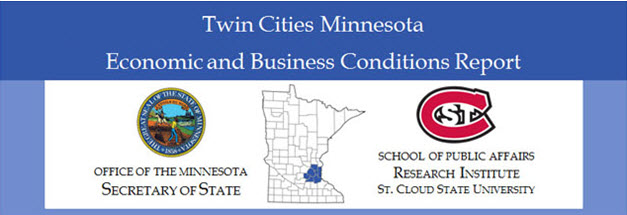Document Type
Research Study
Publication Date
7-2017
Abstract
Strong economic growth is expected over the next several months in the Twin Cities according to the prediction of the St. Cloud State University Twin Cities Index of Leading Economic Indicators (LEI). The Twin Cities LEI rose 10.66 points in the first quarter after a strong reading in the previous quarter. All five index components increased in the first quarter. Lower initial claims for unemployment insurance had a favorable impact on this quarter’s LEI. Strength in two general measures of statewide business conditions also had a positive effect on the index. Higher residential building permits in the Twin Cities MSA and increased new filings of business incorporation and LLC also helped lift the Twin Cities LEI.
There were 11,380 new business filings with the Office of the Minnesota Secretary of State in the seven-county metro area in the first quarter of 2017—representing a 1.5 percent increase from one year ago. There were 1,546 new regional business incorporations in the first quarter, 3.7 percent fewer than year ago levels. First quarter new LLC filings rose to 7,217 in the seven-county metro area—a 5.4 percent increase compared to the first quarter of 2016. New assumed names were 7.1 percent lower in the first quarter and there were 29 more new non-profit filings in the Twin Cities than one year ago.
Sixty percent of new business filers in the Twin Cities planning area completed the voluntary Minnesota Business Snapshot (MBS) survey in this year’s first quarter. Results of this voluntary survey indicate that more than 14 percent of new filers come from communities of color. Nearly 5 percent of new filings are veterans. About 2 percent of new filers come from the disability community and more than 8 percent of new filings are made by the immigrant community. Thirty-seven percent of new business filings in the Twin Cities planning area in this year’s first quarter were initiated by women. MBS results also show that most new business filers in the Twin Cities have between 0 and $10,000 in annual gross revenues (although 673 new filers have revenues in excess of $50,000). The most popular industries for new businesses in the Twin Cities are construction, retail trade, real estate/rental/leasing, professional/scientific/technical, arts/entertainment/recreation, and other services. Employment levels at most new firms are between 0 and 5 workers, and 42 percent of those starting a new business consider this a part-time activity.
Twin Cities planning area employment increased by 1.5 percent over the year ending March 2017. At 3.6 percent, the planning area’s unemployment rate was lower than one year earlier. Initial claims for unemployment insurance were higher than year ago levels, rising by 7.1 percent to 7,369. Job vacancies remain elevated in the Twin Cities planning area. There are now 106.83 job vacancies for every 100 unemployed people in the Twin Cities. The planning area labor force increased by 1.2 percent over the year ending March 2017. Annual bankruptcies continued to decline in the Twin Cities over the past twelve months. Average weekly hours and average hourly earnings were both higher in the metro area and the relative cost of living declined.
Recommended Citation
MacDonald, Richard A. and Banaian, King, "Twin Cities Area Economic and Business Conditions Report - First Quarter 2017" (2017). Twin Cities Minnesota Economic and Business Conditions Report. 13.
https://repository.stcloudstate.edu/qebcr_tc_mn/13




